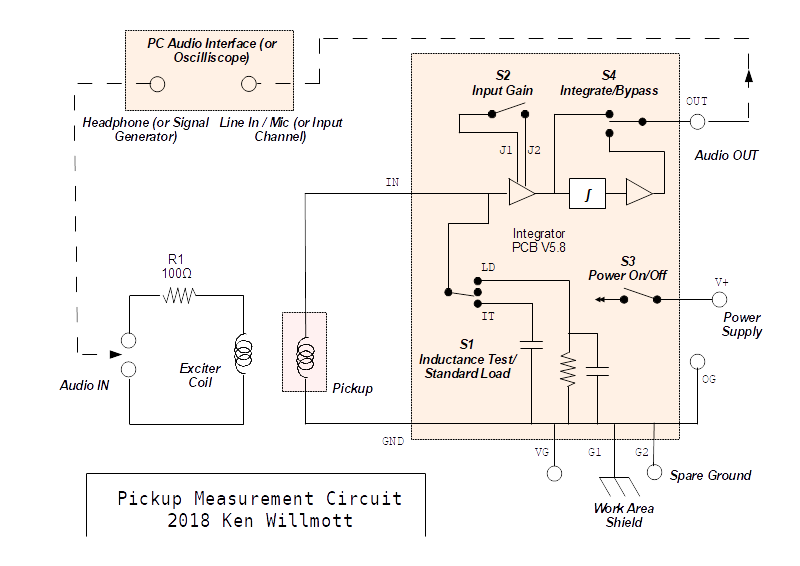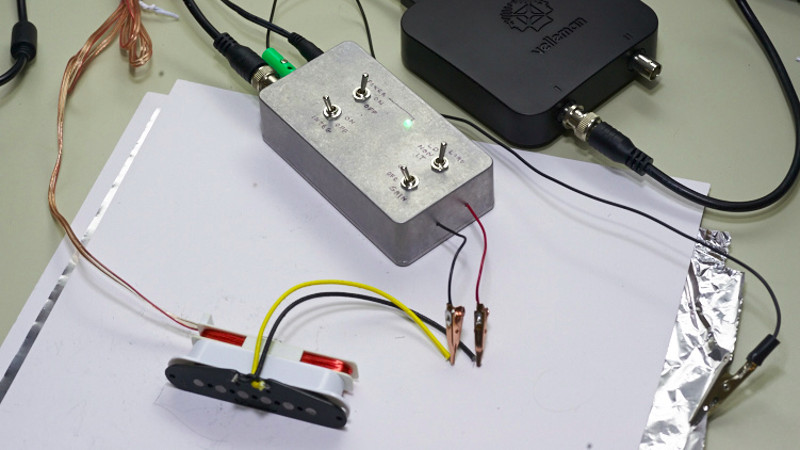To the uninitiated an electric guitar seems fairly simple: you pluck a string and the electronics send the corresponding audio signal on the 6.3 mm jack output, all ready for for the amplifier to work its magic. Much of what makes a guitar like that sound good depends on the pickups, however. These are the devices which are placed between the guitar body and the strings. Depending on the guitar there can be one, two, or more of them, of varying types and configurations.
As a Gibson fan who upon getting introduced to a Fender Telecaster just had to replace its pickups with humbucking types, [Ken Willmott] found himself thrown into the wonderful world of pickup design and characterization. After two years of working through a number of designs and approaches, he eventually settled on a preamplifier design featuring a JFET opamp (LT1058) on a custom PCB which amplifies the pickup response from a test signal, acting as a front end signal conditioner.

The test signal is induced by an electromagnetic coil placed near the pickup-under-test (PUT), with this signal generated by the software on the PC – output via the audio card – or by a signal generator . The effect is similar to that of a metal string moving near the pickup while it’s generating its own EM field. The signal produced by the pickup is then amplified by the custom circuit, where it’s then fed back into the software for characterizing.
The take-away from this is that similarly to devices such as speakers, pickups will respond differently to specific frequencies due to their construction. This is why an original Fender Telecaster sounds so different from a standard Stratocaster model, and why each brand has their own sound courtesy of their preferred pickups. With a test setup such as what [Ken] has made one can figure out what a pickup will sound like without even installing it.
















Interesting. Nice though the LT1058 may be, A JFET opamp is not usually the first thing to come to mind when designing a preamp for a low-impedance source like a pickup (especially the TL084 alternate that is mentioned). It’s not clear from the article what drove that choice. The LT1028 is usually the go-to device for low-signal, low-impedance applications like that.
I’m curious – where does one find a low impedance pickup? Most of the ones I’ve seen have had DC resistances (as measured by a multimeter) in the range 5k-10k ohm or so, and the impedance isn’t going to be less than that. The LT1028 would be a poor choice for this application.
I stand corrected, not recalling pickup impedances being that high. You’re right. The ’58 will start to outperform the ’28 at around 5kohms and higher.
One could use an opamp from this century, making the distinction between those opamps moot.
For example (off the top of my head) the OPA1656 has lower En over the audio band than the LT1058 (despite having a higher 1/f corner frequency).
Smartest dumb thing i have ever read before we get to the z7rt80 lets discuss pole hieght and basic diffrence between a single coil and hum cancellation lol wtf my 4rtfg preamp is driving my ego
From what I know they are medium impedance. You don’t want to load things down at all so high impedance for sensing. They are wound with fine wire. This is why they have such different sounds. Guitarists know pedals may suck the tone by lowering the terminal impedance.
Sori, am an immigrant for now, just learning to strum
Analyzing a pickup:
[pick up guitar]…
[shred]…
“Gah! My ears are bleeding! It sounds like mating rhino’s made of chalkboards and fingernails!”
[next guitar]…
Agreed…..
1st: Pick up guitar.
2nd: Play your guitar of choice.
3rd: If it sounds good to YOU….CONTINUE PLAYING UNTIL SATISFIED!!
4th: After playing your Guitar with Pickups, place said guitar in guitar stand.
5th, Turn off amplifier if an amplifier is in use.
6th: Continue on with what or whomever makes you happy.
7th: Repeat as necessary.
The radio amateur in me now wonders about the possibility of tunable slug pickup cores, even though I prefer music without much guitar or vocal.
Patented by Gil Yaron, the AirGap pickup
I’ve always wondered why they don’t run current through the strings to provide a stronger magnetic signal in the first place, “biasing” the pickup. You could even modulate the current up in the MHz somewhere and demodulate it after the pickup, to reject outside signals.
I don’t know, but is it a good idea to run electricity through a bare wire touched by both hands of the player?
And this is how Big hair bands were born.
Resistivity of stainless steel wire, resistivity of human skin….no problem.
I have been literally knocked on my ass with mustache trimmed by holding an electric and getting too close to a mic fed into the other half of house ac. Blue flash big fun
Attempted to make low impedance pickups when getting into guitar playing. Nobody liked the sound – it was too flat. It seems that people like what they’re used to – the sound of a resonant hump an octave or 2 above the highest note and then a steep roll off. For playing clean anyhow.
If playing into something high gain, I always wind down the tone pot beyond the point where the resonant hump has vanished and the roll off smoothed. It then wouldn’t make much difference whether or not the impedance is low or high – but if low, it’s due to low turn count and so the output would be low – making gain harder.
After lots of faff, eventually concluded that a low impedance pickup, matching (or at least thereabouts) the impedance of balanced microphone cable – feeding into a balanced input, could keep noise nice and low. But that wouldn’t work with any present amps.
So best stick with standard pickups as then they work with amps you can actually buy. Just take your phone out of your pocket when playing to cut down on interference.
Oh, and the impedance of pickups should be 11. Everything guitar should be 11. Not 10.
The op-amp is there to give a -6dB/octave filter, to counteract the 6dB/octave behaviour of the driver coil/pickup link.
The variable loads are there to a) simulate the guitar controls, the cable and the input impediance of the guitar amp as all of these have an effect on the tranfer characteristic of the pickup b) use the unloaded behaviour to calculate the capacitance of the pickup and c) use a much larger capacitor of known value to measure the inductance of the pickup.
What’s missing here is the software required to produce a frequency response plot using the soundcard. Rightmark kind of works but is a bit rudimentary. A cheap USB oscilloscope that does bode plots works much better than a soundcard. I think you can pick up a Syscomp for $50.
What software is he using to generate and evaluate the signals?
Thanks
So the problem here is that the way a pickup sounds in a real-world setting has a ton to do with the shape and size of the magnetic field and how it sits relative to the strings, as well as lots of other, less obvious things that are around it. A big part of the way a telecaster sounds isn’t just the actual pickup, but the design of the bridge has a radical impact on the shape of the field, which will itself determine how much of the string is actually getting picked up by the pickup. A pickup with a wider coil design like a P90 or a traditional humbucker will have a wider field that extends further along the string itself, it will pick up and emphasize deeper and richer sounds. A classic danelectro ‘lipstick’ pickup has wire randomly wrapped around the magnet and the whole thing is cased in a big metal tube. The field is broad, there’s a lack of definition between strings because you don’t get the pole pieces focusing it, and then there are microphonics with the metal tube around the pickup vibrating. That doesn’t even begin to factor in what might have the biggest impact on the sound of the pickup, which is the physical placement along the body. The same pickup placed at the bridge position of any guitar will sound much, much different than the same pickup placed near the neck.